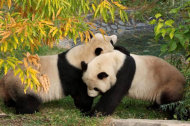A giant panda cub born one week ago at the National Zoo in Washington D.C. has died.
Panda keepers and volunteers heard a distress call from the unnamed cub's mother, Mei Xiang, at 9:17 a.m., today, the zoo said in a statement.
The zoo's Panda Cam, which has for 18 years allowed people around the world to watch the bears in their habitat, was turned off. Veterinarians were able to safely retrieve the panda an hour later, according to the zoo.
CPR and other life-saving measures were attempted, however the cub failed to respond, zoo officials said.
The cause of death is still undetermined. Veterinarians said the cub was in "good body condition," weighing in at just under 100 grams and that there were no visible signs of trauma or infection.
The unnamed cub was born last Sunday night and has not been seen by the public.
"She [Mei Xiang] has a huge nest of bamboo, so it's normal not to see the cub," chief veterinarian Suzan Murray told "Good Morning America" on Monday.
"We rely a lot on the sound. We like to hear a little squawking and we're hearing a lot of squawking," she said.
The birth was Mei Xiang's second as the result of artificial insemination. She gave birth to her first cub, Tai Shan, in 2005. Tian Tian, 15, is the father of both of Mei Xiang's cubs.
Mei Xiang, 14, has had five consecutive pseudopregnancies since 2007 and had a less than a 10 percent chance of being pregnant after so many failed attempts.
With only 300 pandas left in breeding zones and zoos around the world, Mei Xiang and the father of the new cub have become public symbols for endangered species and conservation efforts.
As part of Chinese President Hu Jintao's official state dinner welcome in January 2011, the announcement was made of a new five-year, $2.5 million deal between the Smithsonian Institution and the China Wildlife Conservation Association. The Panda Cooperative Research and Breeding Agreement allowed Washington's furriest duo to stay in the nation's capital.
"Pandas are such a good ambassador for conservation and they highlight all that we do here at the zoo," Murray told "GMA." "Everybody is thrilled. We're thrilled nationally, globally. It's a nice image of the partnership we have with our Chinese colleagues."
U.S.-China relations have been never been simple. But panda diplomacy is not a new tactic in strengthening international ties. Since the Tang Dynasty from A.D. 618 to 907, China has been sending its national treasure to other countries as a symbol of gratitude.
The first panda couple to be donated to the American people followed President Richard Nixon's historic 1972 trip to China, one that marked a new beginning for the longtime foes. Greeted with an official ceremony hosted by the first lady, Ling-Ling and Hsing-Hsing lived at the National Zoo for more than 20 years.
Also Read












1,851 comments